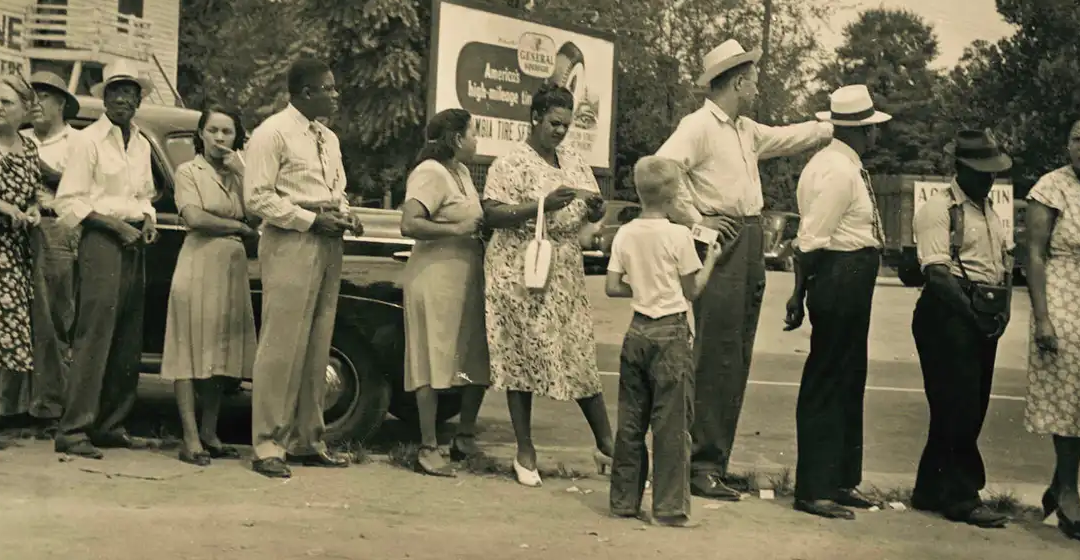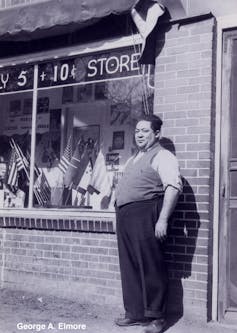
How one man fought to end whites-only Dem primaries – and why that matters now

University of South Carolina Civil Rights Center, CC
A rusting chain-link fence represents a “color line” for the dead in Columbia, South Carolina. In Randolph Cemetery, separated by the barrier from the well-manicured lawn of the neighboring white graveyard, lies the remains of George A. Elmore.
A black business owner and civil rights activist, Elmore is little remembered despite his achievement. But a granite monument at his grave attests to the “unmatched courage, perseverance and personal sacrifice” that saw him take on the South Carolina Democratic Party of the 1940s over its whites-only primaries – and win.
Nearly 75 years after Elmore’s battle, the 2020 Democratic presidential candidates made fervent appeals to African American voters in South Carolina ahead of the primary being held on Feb. 29. For some of the all white front-runners in the race, it could be a make-or-break moment – a failure to win over sufficient black support would be a major setback, potentially campaign-ending.

University of South Carolina Civil Rights Center, CC BY
It is a far cry from the South Carolina of August 1946, when Elmore, a fair-skinned, straight-haired manager of a neighborhood five-and-dime store, consulted with local civil rights leaders and agreed to try once again to register to vote.
It followed blatant attempts to deprive African American citizens of their constitutional rights by white Democratic Party officials who would move voter registration books from store to store and hide them the moment a black voter entered.
When a clerk mistakenly allowed Elmore to register – thinking he was white, contemporary sources suggest – NAACP activists had a plaintiff to challenge the last whites-only primary in the nation.
‘Let the chips fall’
Excluding black voters at the ballot had already been ruled unconstitutional by the U.S. Supreme Court in 1944’s Smith v. Allwright decision. But in defiance, the South Carolina General Assembly simply redefined the state’s Democratic Party as a private club not subject to laws regulating primaries. Gov. Olin D. Johnston declared: “White supremacy will be maintained in our primaries. Let the chips fall where they may.”
Elmore’s name was promptly purged from the rolls and a cadre of prominent civil rights activists arranged for the NAACP to plead his case.
Columbia civil rights attorney Harold Boulware filed the federal lawsuit. In June 1947, Thurgood Marshall and Robert Carter – like Boulware, graduates of the Howard University School of Law – argued Elmore’s case as a class lawsuit covering all African Americans in the state of voting age. The trial inspired a packed gallery of African American observers, including a young Matthew J. Perry Jr., a future federal district judge, who commented: “Marshall and Carter were hitting it where it should be hit.”
In July, an unlikely ally, Charleston blueblood Judge J. Waties Waring agreed, ruling that African Americans must be permitted to enroll. “It is time for South Carolina to rejoin the Union,” he concluded. “It is time … to adopt the American way of conducting elections.”
The state Democratic Party again defied the ruling, requiring voters to sign an oath supporting segregation. Judge Waring issued a permanent injunction in 1948 to open the voting rolls: “To say that these rules conform or even pretend to conform to the law as laid down in the case of Elmore v. Rice is an absurdity.”

South Caroliniana Library, University of South Carolina, CC BY
In that year’s state primary, more than 30,000 African Americans, including George Elmore and his wife Laura, voted. Elmore remarked, “In the words of our other champion, Joe Louis, all I can say is ‘I’m glad I won.’”
His photos of the long line of voters in his community’s precinct are now in the archives of the University of South Carolina where I teach history.
In the years that followed, voter education and registration programs by civil rights organizations transformed the Democratic Party in the state, both in terms of the makeup of its membership and the policies it pursued. The move sparked the departure of many white Democrats to the Republican Party, including the segregationist Sen. Strom Thurmond.
Thurmond’s defection in 1964 legitimized the move for other white Democrats and hard-core segregationists who aligned themselves with an increasingly conservative Republican Party. Not surprisingly, some of the key architects of Richard Nixon’s invidious Southern strategy, which sought to weaken the Democratic Party in the South through the use of dog-whistle politics on racial issues, came from South Carolina.
As this year’s presidential candidates focus on South Carolina, it is clear that the racial makeup of the state’s electorate is vastly different than that in Iowa or New Hampshire, two of the states where the popularity of candidates has already been tested. But Democrats should view the South Carolina primary as more than a shift from voting in small, mostly white states. They should see the state as representative of the party’s strategic core, a strong African American constituency with diverse interests and perspectives.
African Americans in South Carolina have been fighting and winning legal and political battles for voting rights and electoral power since Reconstruction and as Democrats since the 1940s.
A personal price
After Elmore’s victory in 1947, state NAACP President James M. Hinton gave a somber, prophetic warning: “White men want office, and they want the vote of our people. We will be sought after, but we must be extremely careful who we vote for. … We must have a choice between those who have fought us and those who are our friends.”
George Elmore and his family paid a price for challenging the entrenched power of the white Democratic Party in 1946. In an interview with the University of South Carolina’s Center for Civil Rights History and Research, which I lead, his 81-year-old son Cresswell Elmore recalled the retaliation the family experienced. Ku Klux Klan terrorists burned a cross in their yard and threatened their family. Laura Elmore suffered a nervous breakdown and went into a mental hospital. State agents raided Elmore’s liquor store, claiming the liquor he had bought from the standard wholesaler was illegal, and broke the bottles. Soda bottling companies and other vendors refused to send products on credit. Banks called in loans on their home and other property. Forced into bankruptcy, the family moved from house to house and the disruption scattered Cresswell and his siblings. When Elmore died in 1959 at the age of 53, only scant attention was paid to his passing.
The monument at his grave was unveiled in 1981, at a ceremony attended by civil rights veterans including his original attorney, Harold Boulware.
As the Democratic Party and presidential candidates appeal to African American voters, they would do well to remember the remarkable fight Elmore and others waged against the forces of bigotry and injustice. These historical struggles illuminate both the gains made over many generations and the ongoing battle against inequities and voter suppression tactics that persist to this day in South Carolina and across the nation.
[Deep knowledge, daily. Sign up for The Conversation’s newsletter.]![]()
Bobby J. Donaldson, Associate Professor of History; Director Center for Civil Rights History and Research, University of South Carolina
This article is republished from The Conversation under a Creative Commons license. Read the original article.


/https://static.texastribune.org/media/images/2015/08/03/_BDB5793TT_nhmM5Rw.jpg)